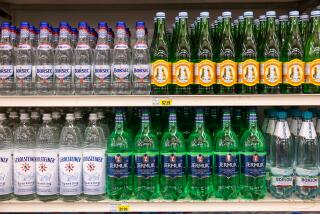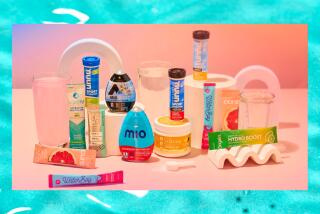Despite the Hype, It’s Plain Old Water
- Share via
A co-worker has started collecting different brands of bottled water: I strolled by his desk the other day, and there they were, all arranged in a line. But (the following to be uttered in an annoying, singsong voice) . . . I’ve got one that he hasn’t got. It arrived just the other day, in a box adorned with pictures of water molecules and with glossy sheaf of informational material.
This isn’t any ordinary water, we’re told. It’s specially formulated “completely through physics” so that it “energizes the body faster by hydrating cells more rapidly.” The key, we’re told: a secret process that clusters water molecules in small groups of five instead of sticking them together in huge clumps that can’t easily enter cells.
I stared, rapt, at a picture of two cells. One is fat and turgid--and flower-shaped groups of five water molecules are moving smoothly into it. The other cell--yeuch!--is ugly and shriveled, and there’s an unruly mob of stuck-together water molecules skulking outside, unable to gain admittance. (The mob looked ugly--not sure I’d want it in my cells.) I did a quick poll, and the folks sitting near me said they definitely preferred the fat-and-turgid type in their bodies.
But . . . isn’t all water pretty much the same? Utter such a statement to “the growing legion of celebrities, models, media personalities, athletes and everyday people who have tried [this] water . . . and chances are you’ll be met with gasps of dissent and lectures on molecular restructuring,” we read.
Penta water fans such as “Married . . . With Children” star Christina Applegate and Jodie Foster’s hairstylist aren’t in my Rolodex, so instead I had to call UC Berkeley chemist Richard Saykally for my structured water lecture. (Saykally has penned articles on water for journals such as Science, and he has a Web site chock-full o’ water facts.)
“It’s a bunch of nonsense,” Saykally says brusquely of my cherished bottled water. And not new nonsense--”structured water” comes up time and again, he says. He recalls specially structured water that was supposed to make your clothes cleaner. Specially structured water that supposedly kept golf courses verdant with one-quarter the watering.
And then, he recalls, there was the famous case of the structured water purported to retain “memory” of chemicals that were once in it--long after the chemicals had been diluted away. This, which if substantiated would provide a mechanism for homeopathy, created quite a fuss in the scientific community for a spell. But it was discredited after no one else could get the experiment to work.
Saykally’s not saying that water never forms little clusters of five--he’s studied those clusters himself. He’s saying that it’s impossible to get water to stay in that shape. Water is constantly on the move--making and breaking bonds with other water molecules a trillion times a second, faster than any delivery service can get the water to you.
Water, he adds, “will adopt whatever shape it needs to do whatever it needs to do”--including entering our cells. Still, “if any of these people can really produce penta water, they’re very likely to win a Nobel Prize. They should send their results to Stockholm ASAP.”
More on the Wet Stuff
Here, while we’re at it, are some water factoids:
* Humans are about 60% water by weight. When our bodies lose 1% to 2% of that water, our brain tells us we’re thirsty.
* We get a lot of the water we need from foods. Bread, for example, is about 38% water, meats about 50% water--even dry crackers are about 4%.
* We secrete oodles of water (9 liters) each day in saliva, stomach juices, bile, pancreatic juice and enzymes, and intestinal juice. Luckily most gets reabsorbed into our bodies.
* We lose 1 to 2 1/2 liters of water through urine each day, 400 to 600 milliliters from sweat, and 300 to 500 milliliters of water just from breathing out.
A postscript: Despite its debunking, my bottle of penta water did some good: I just donated it to my colleague’s water bottle collection. And let me tell you, he was thrilled.
*
If you have an idea for a topic, write or e-mail Rosie Mestel at the Los Angeles Times, 202 W. 1st St., Los Angeles, CA 90012, rosie.mestel@latimes.com.






